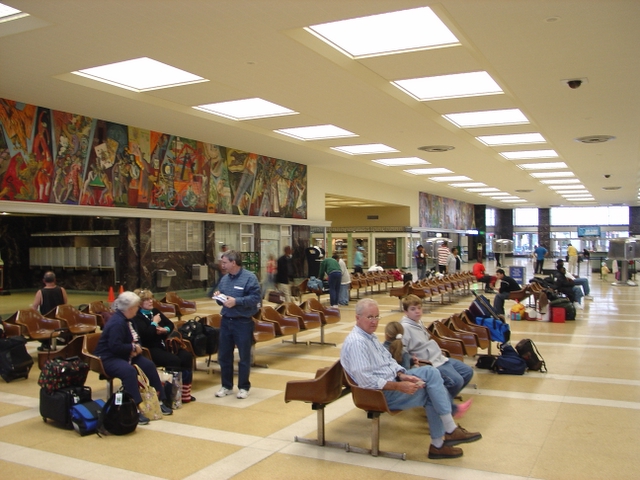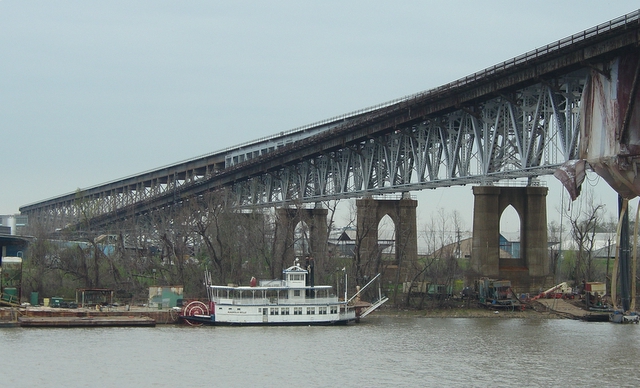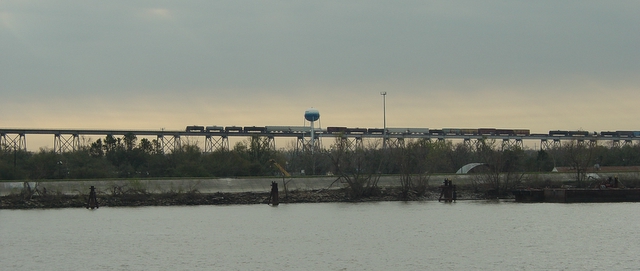America by Amtrak,
Coast-to-Coast and Border-to-Border
Sunset Limited New Orleans and Los Angeles
New Orleans - Houston - San Antonio - Tucson - Maricopa - Los Angels, 1,995 Miles

July 20 - 22, 2016
Photography and text by Carl Morrison Carl@TrainWeb.com
(Click any image for a larger
copy; Click BACK in your Browser to return to this page.)
The last leg of this dream train trip covering 25 states on 6 Amtrak Long Distance Trains with 7,638 rail miles was to take the Sunset Limited 1,995 miles from New Orleans back home to Los Angeles, California.


The map above is from
http://sharemap.org/public/Amtrak_Sunset_Limited#!flash and you can
zoom on any portion, right down to street names.
This was what I like in a two-night train
trip in a roomette. Leave at 9 a.m. (not in the middle of the
night like we had in Charlotte). Arrive first thing in the
morning, in time to take our 35 minute ride out to our home station
Fullerton, California.
 Time to leave the New Orleans Amtrak Station on the Sunset Limited for home, Los Angeles, California.
The photo above was taken about 2006 when we were in New Orleans, arriving there on the City of New Orleans. That report is at: http://trainweb.org/carl/RailsToRiverboats/
Time to leave the New Orleans Amtrak Station on the Sunset Limited for home, Los Angeles, California.
The photo above was taken about 2006 when we were in New Orleans, arriving there on the City of New Orleans. That report is at: http://trainweb.org/carl/RailsToRiverboats/
 As the morning sun hits the east side of the Mercedes-Benz Superdome, we head west.
As the morning sun hits the east side of the Mercedes-Benz Superdome, we head west.
 and past the nearby Smoothie King Center.
and past the nearby Smoothie King Center.
The
Smoothie King Center is a multi-purpose indoor arena in New Orleans,
Louisiana. It is located in the city's Central Business District,
adjacent to the Mercedes-Benz Superdome. The arena opened in 1999 as
New Orleans Arena and has been home to the New Orleans Pelicans of the
National Basketball Association (NBA) since 2002. The New Orleans
VooDoo of the Arena Football League played their home games in the
arena from 2004 until the team disbanded in 2008. The VooDoo resumed
play at the arena in March 2011, until after the 2015 AFL season when
the franchise folded.
From: https://en.wikipedia.org/wiki/Smoothie_King_Center


I-10 built above flood plains, but railroads still suseptible to high water.

East Bridge JCT.

Long, elevated approach to the Huey P. Long Bridge.

The Huey P. Long Bridge, located in
Jefferson Parish, Louisiana, is a cantilevered steel through truss
bridge that carries a two-track railroad line over the Mississippi
River at mile 106.1 with three lanes of US 90 on each side of the
central tracks. Opened December 1935. The bridge
now consists of three 3.3-meter (11-foot) lanes in each direction, with
inside and outside shoulders. Prior to the expansion, there were two
2.7-meter (9-foot) lanes in each direction with no shoulders.
From: https://en.wikipedia.org/wiki/Huey_P._Long_Bridge_(Jefferson_Parish)

Huey P. Long bridge combining I-90 and the railroad.
 New Orleans Skyline, with Superdome, from Huey P. Long Bridge.
New Orleans Skyline, with Superdome, from Huey P. Long Bridge.

Barges and unloading docks in the Mississippi River mile marker 106.1

Telephoto shot of New Orleans from the
Sunset Limited west of town on the Huey P. Long Bridge.
 Photos above and below the Huey P. Long Bridge that I took from a river barge about 2006.
Photos above and below the Huey P. Long Bridge that I took from a river barge about 2006.

 Fire station below the Huey P. Long Bridge. I wondered about the involvement of this station during Hurricane Katrina.
Fire station below the Huey P. Long Bridge. I wondered about the involvement of this station during Hurricane Katrina.
 You can see the proximity to the Mississippi River.
You can see the proximity to the Mississippi River.



 HLCX is Helm Financial, a leasing company that leases locomotives
to railroads. Owner: Helm Financial
Model: Rebuilt EMD GP38-2 Built
As: SAL 600 (GP40) Built:
5/1966
HLCX is Helm Financial, a leasing company that leases locomotives
to railroads. Owner: Helm Financial
Model: Rebuilt EMD GP38-2 Built
As: SAL 600 (GP40) Built:
5/1966




 Ancient cemetery trackside.
Ancient cemetery trackside.
 Typical scene of Louisiana bayou with Spanish Moss on the trees.
Typical scene of Louisiana bayou with Spanish Moss on the trees.
 Business
Business by a w
aterway


Two-lane blacktop through sugar cane field with ample warning signs.
Today, Louisiana sugarcane yields range from 30 to 50 tons per acre,
with recoveries ranging from 180 to 240 pounds of sugar produced from
each ton of cane. These sugar levels rival yields obtained in the more
tropical sugarcane-growing regions. That's why sugar continues to be a
major part of the south Louisiana economy.
 Full train of covered hopper cars through a sugar cane field.
Full train of covered hopper cars through a sugar cane field.

Louisiana and Delta Railroad (reporting mark LDRR) is a short-line railroad headquartered in New Iberia, Louisiana.
LDRR operates over 114 miles of branch line in southern Louisiana
between Lafayette, Louisiana and Raceland, Louisiana, with most of the
lines near US 90. LDRR operates via trackage rights on the BNSF
Railway. LDRR traffic generally consists of bauxite ore, carbon black,
fertilizer, molasses, oilfield supplies, paper products, pipe, sugar
and rice.
The lines were built between 1880 and 1890. LDRR started in 1987 with
the sale of seven Southern Pacific lines to Genesee and Wyoming.
From: https://en.wikipedia.org/wiki/Louisiana_and_Delta_Railroad
 Lots of water in Louisiana, with US 90 always nearby.
Lots of water in Louisiana, with US 90 always nearby.

 Rusty roofed church
Rusty roofed church
 Oil drilling pipe.
Oil drilling pipe.
 Morgan City, Louisiana
Morgan City, Louisiana





US 90 bridge from Morgan City to Berwick, Louisiana
 Southwest Reef Lighthouse tower stands on the western bank of the
Atchafalaya River in Berwick in Everett S. Berry Lighthouse Park,
Louisiana.
Southwest Reef Lighthouse tower stands on the western bank of the
Atchafalaya River in Berwick in Everett S. Berry Lighthouse Park,
Louisiana.
More information at: http://www.lighthousefriends.com/light.asp?ID=341





 The name says, "Fred I. Getty - 1938" Jennings, Louisiana
The name says, "Fred I. Getty - 1938" Jennings, Louisiana
 Implement yard with many-tired implements, perhaps for rice farming.
Implement yard with many-tired implements, perhaps for rice farming.
 Evidence of oil production in those tanks in Westlake.
Evidence of oil production in those tanks in Westlake.

 Could be a former rice Co-operative elevator.
Could be a former rice Co-operative elevator.
 Egrets in the pine trees.
Egrets in the pine trees.
 Beaumont, Texas
Beaumont, Texas
 Another abandoned rice elevator.
Another abandoned rice elevator.



 We had a new baggage car in our consist.
We had a new baggage car in our consist.
 Our car attendant, left, was on this run for the first time from his regular run on the City of New Orleans.
Our car attendant, left, was on this run for the first time from his regular run on the City of New Orleans.
He worked hard to learn the job and do a good job.
 Knowing many hurricanes come out of Texas, I thought this cloud bank might be brewing up one.
Knowing many hurricanes come out of Texas, I thought this cloud bank might be brewing up one.

 The last car in an Amtrak train is a good place to capture railroad activity.
The last car in an Amtrak train is a good place to capture railroad activity.

To this sign, I wish they had added 1,995 miles total, or "
363 to New Orleans and 1,652 to LA".
 Houston skyline.
Houston skyline.
 With a stop such as this with an hour in the station for crew
change, etc. it gives you time to stretch your legs and take some
exterior photos of your train. It is hard to take a photo without the setoff "Amtrash".
With a stop such as this with an hour in the station for crew
change, etc. it gives you time to stretch your legs and take some
exterior photos of your train. It is hard to take a photo without the setoff "Amtrash".

I noted the irony of an American train with Japanese support
vehicle. I do note that these tractors are made in Gainesville,
Georgia.

Seldom is the locomotive this close to the city sign.




Houston Amtrak waiting area.


We headed south of Houston on a detour because of track work.

Matthew awaiting dinner call.

Interesting thunder heads around Houston.

Brazos River

The next day, we were in typical Southwest terrain.

Marathon Coffee in Marathon, Texas.

Alpine, Texas


Alpine, Texas

Isn't that the same elephant cloud I saw north of New Orleans?

Typical southwest scenery through New Mexico, Arizona, and California until San Bernardino.

Rain in the desert.

Some beautiful southwest scenery from the upper level of a Superliner on the Sunset Limited.



Appropriately, our last night on the Sunset Limited had a spectacular sunset.
Since we arrived back in Los Angeles about 5:25 a.m., once we hit the
rack after dark in Arizona, there were no more photos until we got home.
Amtrak Guest Rewards and Amtrak
ticketing seem to be two separate and unrelated systems. After
arriving back in LA at 5:25 a.m., with a 7:25 a.m. train back to
Fullerton, I went to the Metro Lounge to see if there was an earlier
train to Fullerton, 1/2 hr. away. The lounge attendant called and
handed me the phone. Yes, there was a 6:08 train to Fullerton,
but there would be a points deduction to cancel my current reservation
and change it to the earlier train. Forget that, I decided to
stay in the Metro Lounge for those 2 hours, enjoy the amenities, including clean
restroom, and Matt brought in Starbucks from the in-station store.
----------
As I expected when I
began this train trip covering 25 states on 6 Amtrak Long Distance
Trains with 7,638 rail miles, it was a trip of a lifetime.
Son Matthew and I had both
accumulated over 40,000 Amtrak Guest Rewards points and this trip
consumed all our points. His points were accumulated by trips
into Los Angeles where he was a pipe organ repairman for a year.
I accumulated points from Amtrak Guest Rewards Points sales and an
Amtrak credit card. Contacting hotels in the five destination
cities provided hosted of discounted accommodations in return for an
evaluation and photos in this report. I also contacted a city
tour company in each city for a hosted tour. As you have seen at
the end of each train or destination page in this report, we used Uber
extensively always having a low-cost, excellent experience.
Thanks to Bob Williams, a
friend for over 50 years, for showing us around Chicago for three
days. Thanks to brother Don Morrison and wife Suzanne and their
daughter Beth Weast and husband Robbie and newborn Keller for hosting
us in Charlotte.
Finally, thanks to Steve
Grande, owner of TrainWeb.com, for hosting these rail journey webpages
as well as over 100 other rail reports since 1998 at TrainWeb.org/carl.
Carl "Hobo Mo" Morrison





